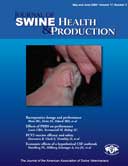Abstract:

Use of a one-dose subunit vaccine to prevent losses associated with porcine circovirus type 2
Robert Desrosiers, DVM, Dipl ABVP; Edward Clark, DVM, MVSc, Dipl ACVP; Dorine Tremblay, DVM; Robert Tremblay, DVM, DVSc, Dipl ACVIM; Dale Polson, DVM, PhD
Complete article is available online.
PDF version is available online.
In a commercial swine herd in eastern Canada, porcine circovirus associated disease (PCVAD) had been occurring for about 18 months when a test vaccine was introduced. Pigs were affected approximately 3 weeks after entering the finishing units. A total of 3852 pigs were enrolled in the study. Half of the pigs were randomly selected to be vaccinated at 19 to 59 days of age with a one-dose porcine circovirus type 2 (PCV2) vaccine (Ingelvac CircoFlex; Boehringer Ingelheim Vetmedica Inc, St Joseph, Missouri). The other half of the pigs were injected on the same day with sterile water (controls). No local or systemic adverse reactions were observed. The study pigs were placed in four different finishing units and in each one, mortality was significantly lower in vaccinated pigs (P < .01). Enlarged lymph nodes and white spots on the kidneys were among the most frequent lesions suggesting PCVAD. Splenic infarcts were observed in a few pigs. Results of two different serological tests showed that pigs could be effectively vaccinated in the presence of maternal immunity. There was no correlation between seroconversion (in response to vaccination) and protection.
Keywords: porcine circovirus associated disease, porcine circovirus vaccine, mortality, serological response, PCV2, PCVAD
![]() Cite as: Desrosiers R, Clark E, Tremblay D, et al. Use of a one-dose subunit vaccine to prevent losses associated with porcine circovirus type 2. J Swine Health Prod 2009;17(3):148-154.
Cite as: Desrosiers R, Clark E, Tremblay D, et al. Use of a one-dose subunit vaccine to prevent losses associated with porcine circovirus type 2. J Swine Health Prod 2009;17(3):148-154.
Search the AASV web site for pages with similar keywords.
